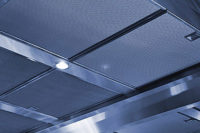
What if you could see into the future and see how your past health care designs might affect a facility in the future? You can; you just need to take the time to learn from the past. Or even better, learn from the past of others whose designs didn’t go quite as well as they had expected, thanks to this thoughtful interrogation from a forensic engineer.
The design process for a new health care facility, with its rushed schedules and tight budgets, can be a demanding challenge, but it all has to come together with the highest of quality - patients’ lives may be on the line. In the rush to make the perfect health care design, have you ever taken the time to step back and look to see if your efforts met your client’s long-term expectations?

figure
1. Incorrect
diffuser type for operating room - a non-aspirating, low velocity,
low turbulence vertical discharge should be used over sterile field.
(Photo courtesy of Rimkus Consulting Group.)
STERILE ENVIRONMENTS
Infection control and maintaining a sterile environment are critical in health care facilities and are best accomplished by maintaining proper pressurization, airflow, dry conditions, and filtration. You must consider all these in your design, including the operational challenges of constructing and, most importantly, maintaining these new spaces.PRESSURIZATION
Pressurization is usually well-documented in design concepts to maintain the proper relationships between clean and dirty areas, but what happens from design to implementation is often one of the most commonly seen defects. We have seen control strategies that identify building outside air and exhaust fans at a specified air quantity but fail to take into account the variability of fume hood exhaust fans. Does your control strategy take into account how all the different fans will interact under all conditions on the whole building to maintain the proper pressures?What happens when the walls between zones or the building envelope leak more than you anticipated? You do anticipate it will leak, right? We have seen far too many examples of pipe, duct, and conduit penetrations and bad envelope details that allow far more leakage than the supply or exhaust fans can accommodate and waste energy over the life of the project.

Figure
2. Fungal
growth behind vinyl wall paper. (Photo courtesy of Rimkus Consulting
Group.)
Maintenance personnel are notorious for closing outside air dampers to “reduce the outside air load” and believe they are saving operational money when they do so. But in fact they create building depressurizations by not allowing sufficient outside air to offset the building exhaust systems. Have you considered a foolproof control strategy that takes into account “best intention” maintenance modifications to maintaining proper pressure relationships in the needed sterile zones or overall building pressurization?
AIRFLOW
Airflow is critical to maintaining the proper sterile boundaries for operating rooms (ORs) as well as contaminated spaces. Proper diffuser types and layouts are needed to maintain clean air movement over the operating room table. These diffusers should be non-aspirating, low velocity, low turbulence, and directly over the sterile field. We have seen many examples where an aesthetic design of a ceiling takes precedence over a functional grille layout with light fixture and equipment arms competing with grilles for space (Figure 1). Do you require a performance test to determine the actual airflows from your design?For non-sterile spaces, a more turbulent scheme is necessary with higher air velocities and larger quantities of air. The less sterile the space, the more air required to move into the space. Here, the problem again becomes grille locations. This time, the exhaust grilles can rapidly become clogged with debris, significantly reducing the amount of exhaust. Is debris clogging the grille, how will it affect airflow? How do you adjust for this condition (through controls or dampers), or what mechanisms do you provide for cleaning the grilles and plenums behind (easily removable, washable)?
DRY CONDITIONS
Water - high humidity, vapor migration through building materials, and liquid water - can be your worst enemy for maintaining a sterile space. All water sources can harbor fungal and bacterial growth. Relative humidity (rh) levels should ideally not exceed 55%. At rh levels above 60%, the water activity levels of most surfaces will allow mold growth to occur.However, it is not uncommon for surgeons to demand their ORs have the coldest air possible, many times 65°F and lower. However, we have found these cold ORs have a very high rh, many times exceeding 70%. This makes controlling fungal growth a real challenge. If drier air is possible, these low temperatures will not be needed. Consider a dedicated dehumidification strategy in your cooling design. This has the possibility of reducing overall energy use and more importantly will reduce potential moisture as a source of fungal growth.
Inherently, there is a need to be able to clean wall surfaces in a health care facility, and low-permeable and durable materials are often used such as vinyl wall coverings, laminated panels, epoxy, and oil-based paints. If these low-permeability products are used on exterior walls, the potential exists for them to act as a vapor barrier when vapor moves through the wall assemblies from humid outside conditions to the cooler, drier inside conditions.
This trapped vapor can then condense and lead to mold growth (Figure 2). Health care facilities are particularly vulnerable because of the need for durable, washable wall assemblies, colder temperatures, and usually greater building-pressure differentials, all of which contribute to increased vapor movement through exterior wall assemblies. Do you review what exterior wall materials are being used and determine if their permeability will trap moisture in a wall?

figure
3. Condensation
and resultant fungal growth on chilled water piping from humid air
conditions in the ceiling plenum. (Photo courtesy of Rimkus
Consulting Group.)
Often, health care AHUs require high static pressures to overcome higher efficiency filters and thus require that the condensate drainage system be capable of handling those higher pressures. We very often find the condensate drainage systems inadequate, with poor trap designs that hold water in the drain pans. Make sure your trap designs take into account the correct static pressure for the AHU they are connected to and are easily accessible for periodic cleaning.

Improper
condensate drain pan slope and p-trap resulting in accumulated
organic matter. (Photo courtesy of Rimkus Consulting Group.)
Pipes are everywhere in a health care facility, and where there are pipes, there inevitably are pipe leaks. Corrosion is the first problem we see over and over again causing pipe leaks. The corrosion most often comes from the lack of adequate dielectric separation between dissimilar metals (Figure 5). This is a simple enough item to cover in a specification but occasionally gets overlooked during construction. If you have construction administration responsibilities, then you owe it to yourself, and especially your client, to pay particular attention to reviewing field installations for compliance.

Figure
5. Improper
installation of dielectric (missing dielectric sleeves at bolts and
between valve and flanges) corroding bolts and valve body. (Photo
courtesy of Rimkus Consulting Group.)
When those pipes leak, the water tends to hit the floor and spread out until it finds openings in the floor, and then the damage spreads. One important design aspect that is often overlooked, but which can protect all floor penetrations, is to install a sleeve that is at least 1 in. high. Although these penetrations are fire-sealed, often these seals develop small cracks and the water finds a way through. A sleeve, which is also fire sealed, minimizes this possibility.
FILTRATION
Filters are usually properly specified with the proper MERV ratings for the most sterile environments, but have you considered how these filters are maintained? Where is the access to change the filters? Is it in the same sterile area you are trying to keep clean? You need to make filter access as convenient as possible if you expect them to be maintained. Filters installed above ceilings or access doors that do not fully open are not going to be changed as needed. The great battle to maximize useable floor areas often results in mechanical spaces too small to allow maintenance personnel to properly service the equipment.From an operational standpoint, how do you know if your filters are even effective? We tested all our high efficiency filters with particle counters after changeout. You would be amazed at how many filters failed because the filters did not seat tightly against their gaskets. How would you know without testing? Perhaps consider adding filter testing to your start-up protocol. And then are there manometers installed (preferably digital and with remote alarms for high static pressures), so that filters that are dirty will be identified and changed?

figure6.
Containment
during construction. (Photo courtesy of Rimkus Consulting Group.)
CONSTRUCTION PROJECTS
On a final note, it is important to consider how your project will be built in an occupied health care facility. Invariably, because the facility is challenged with keeping up to date with the latest technical upgrades, you will find yourself having to build either attaching to an existing facility or renovating an existing space.Either way, containment and protecting the existing patients during construction is critical. Whether a new or a renovation project, this work is going to be inherently a dirty process that you must isolate from occupied spaces. This is best accomplished with sealed drywall partitions, but can be accomplished with plastic barriers tape sealed (Figure 6). As the designer, you need to consider these barriers and how your project will progress beside and through these partitions at critical times. We have seen many a frustrated designers, contractors, and owners when these barriers are not properly considered during the design phase.



